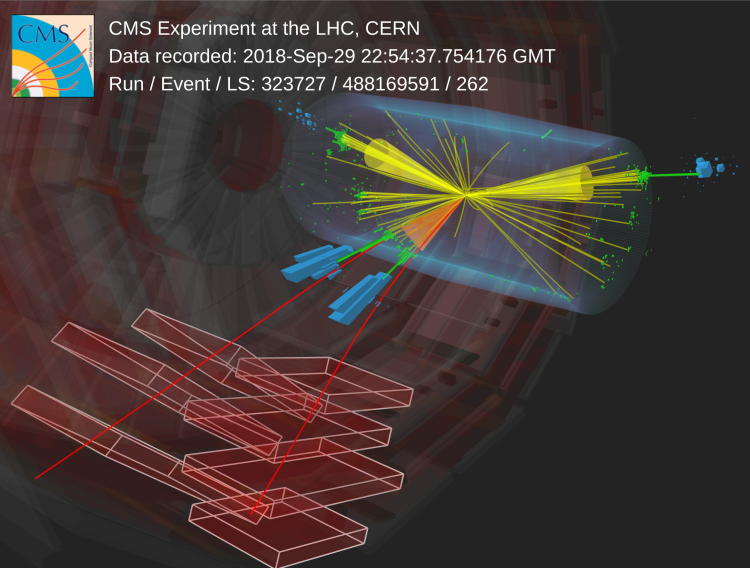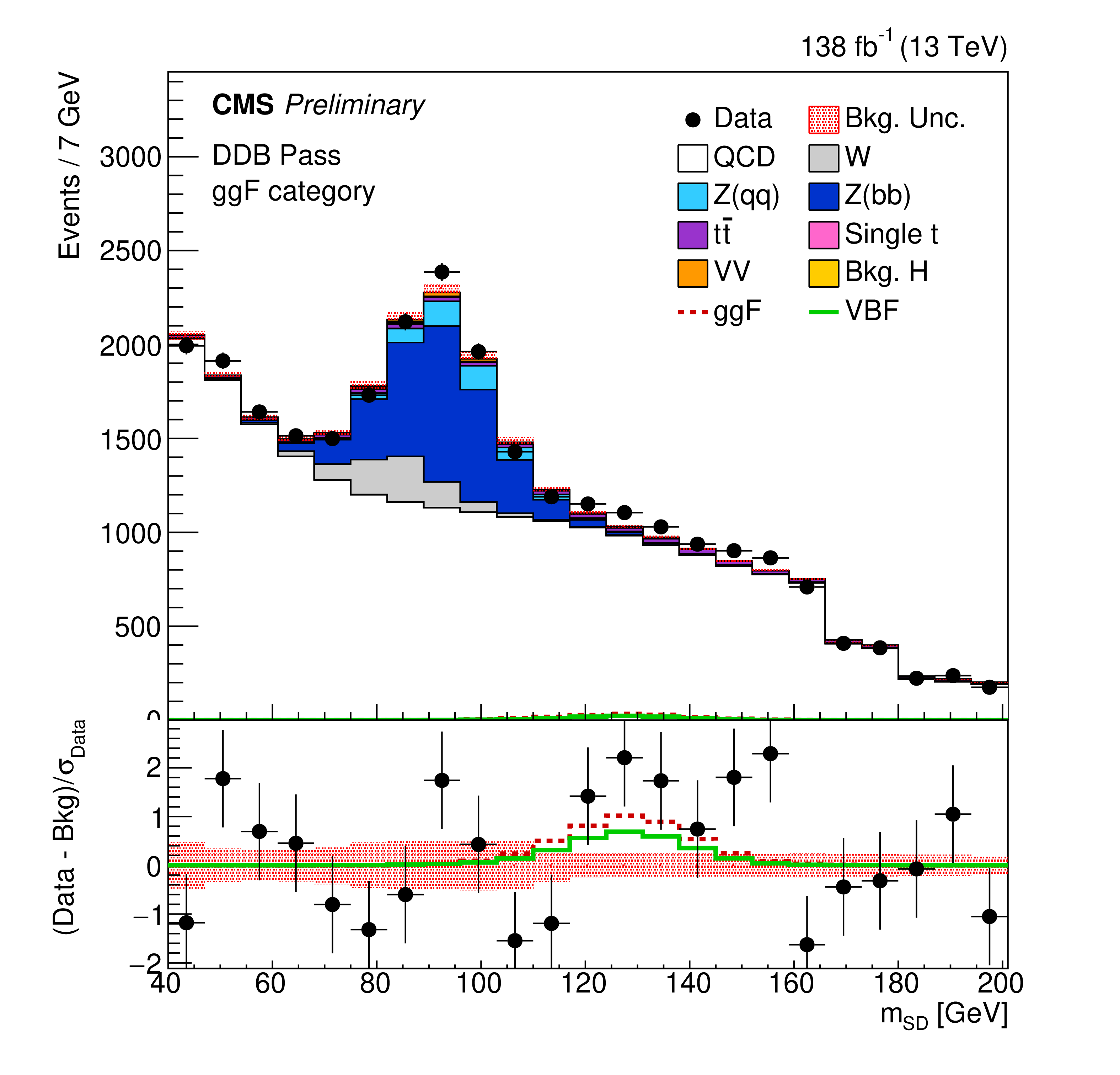
A new search conducted by the CMS collaboration is exploring Higgs bosons with very high energy. Measuring how many high-energy Higgs bosons are created in proton-proton collisions can tell us about new Higgs interactions, either with known particles or with particles we haven’t seen yet.
When a Higgs boson is created, it immediately decays into lighter particles. On average, three out of five Higgs bosons decay to a bottom quark-antiquark pair. Most of the time, the quark and antiquark travel in opposite directions in the CMS detector. In some cases, however, the Higgs boson receives a large amount of energy in the collision (in comparison to its rest mass, using Einstein’s most famous equation) and the quarks move in almost the same direction. This is analogous to what happens if a fireworks explodes when it reaches the highest point of its ascending trajectory (and is, hence, at rest) or while it is moving up at a very high speed.
When the Higgs boson decays to quarks, each quark creates a spray of particles known as a jet. In the high energy case, the jets overlap and create a single object that we call a boosted jet. Boosted jets created by Higgs decays have a few interesting characteristics. A boosted Higgs decay to a quark-antiquark pair contains two distinct clusters of particles, one corresponding to each of the two initial quarks. In addition, it contains heavy particles called b-hadrons, which travel a few millimeters in the detector before decaying. Using a deep learning algorithm, we are able to identify boosted jets that contain two such displaced decays. For more details about this algorithm and others like it, see the CMS Physics Briefing here!
Finally, by collecting and adding up all the energy of the particles in a boosted jet, we can reconstruct the mass of the initial particle. Since this search is targeting Higgs bosons, we are looking for boosted jets that have a reconstructed mass peaking around the Higgs mass, 125 GeV. Physics processes that don’t involve a Higgs boson form the background for this search and will have different values of the reconstructed mass. For example, the well known electroweak force carrier, the Z boson, can also decay to a boosted bottom-antibottom quark pair, leading to a reconstructed mass peak at around 91 GeV. Jets created by single quarks and gluons can have a large range of reconstructed masses, with the lower values being the most common.
There is more than one way to produce Higgs bosons. This search focused on the two most common Higgs boson production modes. Most Higgs bosons at the LHC are produced when two gluons, one from each proton, fuse through a process called gluon-gluon fusion. The second most common Higgs production mechanism is vector boson fusion, which starts with a pair of quarks. Each quark emits a vector boson (W or Z, the weak force carriers) which then fuse to produce a Higgs boson. The initial quarks barely notice that a Higgs boson has been produced - they continue moving along the beamline, almost as if nothing happened! Figure 1 shows a proton-proton collision event whose signature in the CMS detector is compatible with a boosted Higgs boson, a large-radius jet, produced via vector boson fusion.
Figure 1: Visualization of a CMS data event from 2018 that is selected into the VBF category. This event contains one large-radius jet with two-prong substructure and a reconstructed mass of 125.2 GeV (Higgs candidate). The additional two jets separated by a large polar angle are characteristic of the VBF process.
The presence of these extra quarks, which form jets pointing in opposite directions along the beamline, gives us a way to identify the Higgs bosons that were produced by vector boson fusion. We split our boosted Higgs boson sample into two categories: one that has at least two extra jets pointing in nearly opposite directions along the beamline, and one that contains everything else. This split allows us to look separately at the two production mechanisms.
CMS has searched for high energy Higgs bosons before, but this is the first time we are paying special attention to how the boosted Higgs bosons are produced. Because of the different types of particles involved, a new type of particle interaction (absent in the Standard Model of particle physics) could affect gluon-gluon fusion and vector boson fusion in different ways.
The results of this search use all of the data collected by the CMS detector between 2016 and 2018. The reconstructed mass of the collected events is shown in Fig. 2, in the gluon-gluon fusion category and vector boson fusion category.
 |
 |
Figure 2: The reconstructed mass of the collected events is shown in the gluon-gluon fusion category (left) and vector boson fusion category (right). The peak created by boosted Z boson decays to a bottom-antibottom quark pair is clearly visible in blue, while the white distribution represents jets created by single quarks and gluons. The red dashed line shows the yield of gluon-gluon fusion that we measure and the green line shows the same for vector boson fusion.
How does this compare to the expectations? The measured number of Higgs bosons for gluon-gluon fusion agrees well with what is predicted by the Standard Model, but the vector boson fusion measurement shows more Higgs bosons than expected. When we consider both production processes, we see an intriguing discrepancy with the standard model prediction. We have evaluated the probability that this excess is caused by a “random” statistical fluctuation to be only 1%. Quite exciting, indeed.
Considering the very large number of searches made with LHC data, it is not unexpected that a few of them show unlikely results due to pure chance. It is also possible, nevertheless, that the enhancement we have found is due to a new physics process. Alternatively, it might mean that we need to improve the accuracy of the standard model predictions. Whatever the explanation, it is clear that boosted Higgs production at the LHC will be an exciting avenue of research at the LHC in the future!
Read more about these results:
-
CMS Physics Analysis Summary (HIG-21-020): "Search for boosted Higgs bosons produced via vector boson fusion in the H bb decay mode using LHC proton-proton collision data at 13 TeV"
-
@CMSExperiment on social media: LinkedIn - facebook - twitter - instagram
- Do you like these briefings and want to get an email notification when there is a new one? Subscribe here

